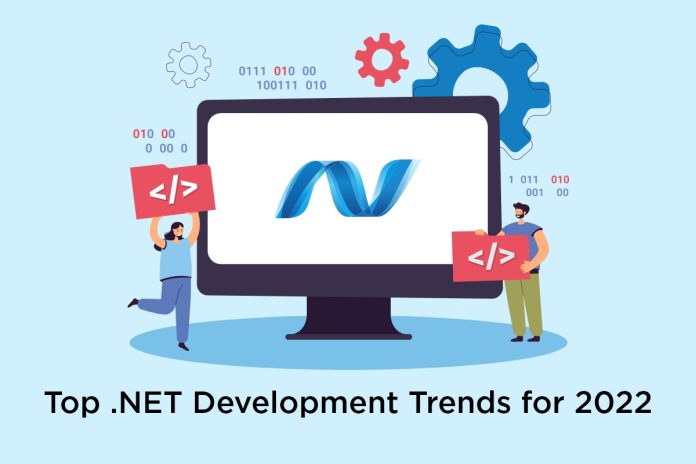Microsoft created the .Net framework as a software development platform. Almost every enterprise software development firm employs it. The framework is useful for developing programs that will run on the Windows platform. The framework is particularly friendly to programming languages like C# and Visual Basic, allowing .NET development services to choose the programming language and construct the desired application.
Microsoft has worked hard to make .NET more accessible to everyone. The framework is simple to use and can run on Windows, macOS, Linux, and other IoT devices. It has demonstrated its worth by creating mobile applications for Android and iOS.
Why .NET?
1. Platform with Full Stack
A software application is divided into three layers: the front end, middleware, and back end. .NET is a full-stack framework that can be used to create complete applications from the front to the back end.
2. Modern
It builds modern software applications by leveraging modern capabilities accessible in modern browsers, the cloud, and other devices.
3. Fast
.NET is one of the most modern software development frameworks. The .NET 6.0 release has been touted as the fastest ever. In addition, it is more efficient and secure.
4. A Sizable Community
The .NET community is one of the largest, with over a million developers from diverse .NET development companies contributing throughout the world.
5. Friendly
It’s compatible with different frameworks and libraries. It may be used to create a huge online application with ASP.NET Core that integrates with Angular and JavaScript.
6. Evolving
All good things must also evolve. .NET 6.0 is the most recent version. In 2022, .NET 6.0 will be phased out and replaced by .NET 7.0. Microsoft has outlined its .NET plans for the coming years.
7. Open Source
.NET projects are now open source and controlled by Microsoft and the open-source community, thanks to the .NET 6.0 release. The relatively low entry hurdles will encourage more framework adoption among the next generation of dot net developers.
.NET Development Trends
1. Web development with Blazor
Blazor is a sophisticated feature of the .NET web development framework that allows a .NET development company to create web apps in C#. It provides reusable web components for use with HTML and CSS. You can use Blazor to write both client and server-side code in the same language. Furthermore, you may connect Blazor to the SignalR to run real-time apps and deliver a unified experience to users by running client events directly on the server.
2. ASP.NET Core advancement
Microsoft is currently releasing new .NET Core upgrades. Its capabilities can be used to create full-stack applications, and REST APIs, and configure bi-directional data transmission in client-server architectures. You may also use a microservices framework to construct autonomous Docker containers to run your application.
3. .NET 6
Microsoft no longer supports .NET version 5.0 and all users are required to upgrade to .NET 6. It is an LTS release that provides steady support for up to three years while also ensuring hot reload, intelligent code auditing, and diagnostics with the Visual Studio 2022 version. Furthermore, you can use Crossgen2 with .NET 6 to reduce application load time.
4. Upgrade Helper
Organisations are having difficulty performing essential processes utilising legacy technologies as their user bases evolve. .NET Upgrade Assistant assists developers & firms providing .NET development services in migrating applications from an outdated platform to a newer version while preserving data. At the moment, it supports the modernisation of a few projects, such as MVC-based applications, consoles, Windows Forms, Windows Presentation Foundation, C#, and Visual Basic.
5. High-tech Security Systems
.NET allows software engineers to protect data integrity, confidentiality, and availability. Advantages: built-in HTTPS module, prevention of scripting attacks by analysing every packet and user request, authentication system to verify each user’s identity, and possibilities to configure role-based security.
6. .NET MAUI
.NET Multi-platform App UI can be used to create native applications. C# and XAML are the key languages for creating programs that can operate on iOS, Windows, Android, and macOS via a shareable source code. MAUI allows you to share single and multiple files from one device to another, keep data secure using the key-value combination strategy, implement text-to-speech modules and analyse network, bandwidth, and latency in real-time.
7. ML.NET
Automating tasks and processing multidimensional data are quickly becoming needs for medium and big organisations. And employing the capabilities of Machine Learning is an excellent solution for such reasons. Custom algorithms, components, and modules for embedding detection, identification, and self-optimization features can be created using ML.NET. Analytics can also be performed by developers using the Apache Spark engine.
Also, read the post on Reasons to Hire A Custom .NET Development Company
8. .NET-based Games
With the .NET game development framework, you can create high-performance games with 4K graphics for desktops, mobile devices, and even VR/AR consoles. A .NET development company can use the Azure cloud to back up their applications in real-time.
9. Integration with the Azure cloud
Nowadays, the majority of applications run on serverless architecture, which you can achieve flawlessly with the Azure Cloud. It is a Microsoft product that works well with any .NET application, whether it be a desktop, mobile, gaming, IoT, or ML project. Furthermore, it includes built-in Signal features for delivering up-to-the-minute data to visitors without changing the present status of a webpage.
10 .NET and IoT
With .NET, you can create IoT applications that provide the current state of each smart device’s hardware and software through a single interface. Its internal architecture works flawlessly with Raspberry Pi, Arduino, Pine A64, and all other popular boards. You can also use the .NET Nano and Meadow IoT frameworks to build, test, deploy and maintain code by directly accessing peripheral components.
Conclusion
.NET has a broad range of applications. .NET has a promising future in 2022. .NET is a modern, quick, flexible, user-friendly, and open-source full-stack framework that is appropriate for all types of scalable software apps. The new features and yearly upgrades bring features that improve speed, lowering the cost and time required for creation.









